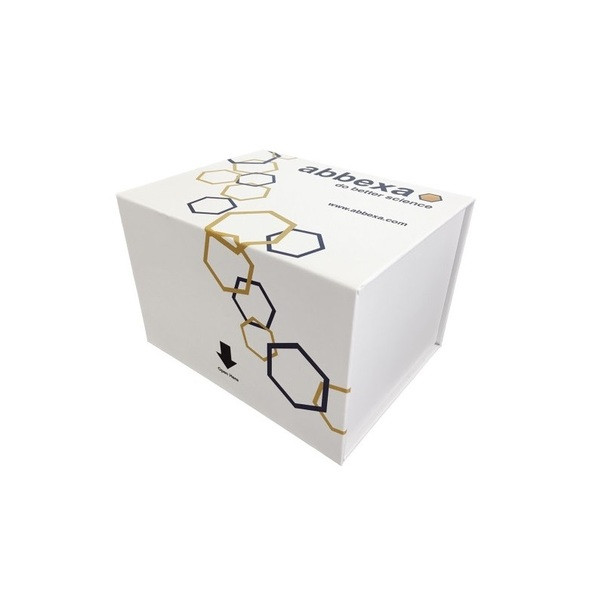Human Prothrombin Fragment 1+2 (F1+2) ELISA Kit | abx252419
- SKU:
- abx252419
- Availability:
- Shipped within 5-12 working days.
- Size:
- 96 Tests
- Clonality:
- N/A
- Tested Applications:
- ELISA
- Host:
- N/A
- Conjugation:
- N/A
- Dry Ice:
- No
Description
Human Prothrombin Fragment 1+2 (F1+2) ELISA Kit. Cat# abx252419. Supplier: abbexa.
Human Prothrombin Fragment 1+2 (F1+2) ELISA Kit is an ELISA Kit for the in vitro quantitative measurement of Human Prothrombin Fragment 1+2 concentrations in plasma.
| Introduction | The conversion of prothrombin to thrombin is a key event in the coagulation of blood. Prothrombin fragment F1+2 is an activation peptide released from prothrombin during thrombin formation. Activation of prothrombin takes place in the presence of factor Xa, factor Va, calcium ions and a phospholipid suface (platelets). Prothrombin fragment F1+2 may be generated during thrombin formation in two ways. Either prothrombin is cleaved to prethrombin 2 and prothrombin fragment F1+2. Subsequently prethrombin 2 is further cleaved at one position to yield active thrombin. The alternative way of activation is that prothrombin is cleaved to meizothrombin still containing the prothrombin fragment F1+2, and is then processed to thrombin, liberating the prothrombin fragment F1+2. The prothrombin fragment F1+2 may further be cleaved by thrombin to fragments F1 and F2. |
| Target | Prothrombin Fragment 1+2 |
| Reactivity | Human |
| Tested Applications | ELISA |
| Recommended dilutions | Optimal dilutions/concentrations should be determined by the end user. |
| Storage | Shipped at 4 °C. Upon receipt, store the kit according to the storage instruction in the kit's manual. |
| Validity | The validity for this kit is 6 months. |
| Stability | The stability of the kit is determined by the rate of activity loss. The loss rate is less than 5% within the expiration date under appropriate storage conditions. To minimize performance fluctuations, operation procedures and lab conditions should be strictly controlled. It is also strongly suggested that the whole assay is performed by the same user throughout. |
| UniProt Primary AC | P00734 (UniProt, ExPASy) |
| UniProt Entry Name | THRB_HUMAN |
| Gene Symbol | F2 |
| OMIM | 176930 |
| HGNC | 3535 |
| KEGG | hsa:2147 |
| String | 9606.ENSP00000308541 |
| Test Range | 46.88 pg/ml - 3000 pg/ml |
| Sensitivity | 28.13 pg/ml |
| Standard Form | Lyophilized |
| Detection Method | Colorimetric |
| Assay Type | Sandwich |
| Assay Data | Quantitative |
| Sample Type | Plasma. |
| Assay Principle | This kit is based on sandwich enzyme-linked immuno-sorbent assay technology. An antibody is pre-coated onto a 96-well plate. Standards, test samples, and biotin-conjugated reagent are added to the wells and incubated. The HRP-conjugated reagent is then added, and the whole plate is incubated. Unbound conjugates are removed using wash buffer at each stage. TMB substrate is used to quantify the HRP enzymatic reaction. After TMB substrate is added, only wells that contain sufficient F1+2 will produce a blue coloured product, which then changes to yellow after adding the acidic stop solution. The intensity of the yellow colour is proportional to the F1+2 amount bound on the plate. The Optical Density (OD) is measured spectrophotometrically at 450 nm in a microplate reader, from which the concentration of F1+2 can be calculated. |
| Kit Components | The kit components listed are for reference only. The product manual may differ slightly. The product should be used as stated on the product manual included and delivered together with the product.
|
| Material Required But Not Provided |
|
| Reagent Preparation | This procedure is provided for reference only. The product manual may differ slightly. The product should be used as stated on the product manual included and delivered together with the product.
|
| Assay Procedure | This procedure is provided for reference only. The product manual may differ slightly. The product should be used as stated on the product manual included and delivered together with the product.
|
| Protocol | This procedure is provided for reference only. The product manual may differ slightly. The product should be used as stated on the product manual included and delivered together with the product.
|
| Results Calculation | For calculation, average the O.D.450 duplicate readings for each reference standard and each sample and substract the average control (zero) O.D.450 reading. The standard curve can be plotted as the relative O.D.450 of each reference standard solution (Y) vs. the respective concentration of each standard solution (X). The F1+2 concentration of the samples can be interpolated from the standard curve. |
| Assay Precision | Intra-assay Precision (Precision within an assay): 3 samples with low, medium and high levels of Prothrombin Fragment 1+2 (F1+2) were were tested 20 times on one plate, respectively. Inter-assay Precision (Precision between assays): 3 samples with low, medium and high levels of Prothrombin Fragment 1+2 (F1+2) were tested on 3 different plates, 8 replicates in each plate. CV (%) = (Standard Deviation / mean) × 100 Intra-Assay: CV<10% Inter-Assay: CV<10% |
| Availability | Shipped within 5-12 working days. |
| Note | This product is for research use only.
The range and sensitivity is subject to change. Please contact us for the latest product information. For accurate results, sample concentrations must be diluted to mid-range of the kit. If you require a specific range, please contact us in advance or write your request in your order comments. Please note that our ELISA and CLIA kits are optimised for detection of native samples, rather than recombinant proteins. We are unable to guarantee detection of recombinant proteins, as they may have different sequences or tertiary structures to the native protein. |
| Plate coated with | Antibody |











